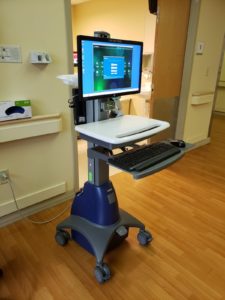Nursing Informatics Series: Olga’s Journey
I always knew I wanted to become a nurse. I wanted to save the world by helping others, and as a young adult, I thought helping others always meant being at the patient’s side.
 As a new graduate, I worked the night shift in a busy emergency room. The chaos of the emergency room only pushed me to learn more. I wanted to be the best nurse I could. I thought the most important thing was to advocate for my patients, to make sure that their care was not only efficient, but the highest quality. After two years working in the emergency department, I took a position in the post anesthesia care unit (PACU). I thought I would work in the PACU until I retired.
As a new graduate, I worked the night shift in a busy emergency room. The chaos of the emergency room only pushed me to learn more. I wanted to be the best nurse I could. I thought the most important thing was to advocate for my patients, to make sure that their care was not only efficient, but the highest quality. After two years working in the emergency department, I took a position in the post anesthesia care unit (PACU). I thought I would work in the PACU until I retired.
The PACU is very similar to the emergency department. Both units keep nurses on their toes. You never know what condition the patient will be in when you receive them. The main difference is the PACU chaos is more organized. I noticed I had similar habits in both units. I constantly ran from place to place, rushing to ensure I could document everything needed, assessments, vital signs, mediations given, and then constant updates as the patient’s condition changed. I never felt as though I did enough because there was never enough time to do it all. I often skipped my lunch break, put off going to the bathroom until my bladder would burst, and still at the end of my day, I would sit and ask, am I helping enough? Is there more I can do? I realized my days consisted of asking questions and spending more time focusing on the documentation needed than the actual patient.
 The ambulatory surgery center where I worked was the only unit of a big hospital that had not migrated to electronic medical records (EMR)–we still used paper charts. I started working with a team to transition to EMR. During the transition I thought, “Why not decrease staff burden and start to eliminate questions asked by the nurses, doctors, or anesthesiologists during the pre-operative screening?” Sometimes it would take me 45 minutes to get the patient ready for a simple outpatient procedure. Using the computer, the pre-operative screening would take longer than the actual procedure because of all the questions and screenings that were required to be documented before the patient could proceed to surgery.
The ambulatory surgery center where I worked was the only unit of a big hospital that had not migrated to electronic medical records (EMR)–we still used paper charts. I started working with a team to transition to EMR. During the transition I thought, “Why not decrease staff burden and start to eliminate questions asked by the nurses, doctors, or anesthesiologists during the pre-operative screening?” Sometimes it would take me 45 minutes to get the patient ready for a simple outpatient procedure. Using the computer, the pre-operative screening would take longer than the actual procedure because of all the questions and screenings that were required to be documented before the patient could proceed to surgery.
I started asking questions. Why do I have to ask my patients about the flu shot? Why do I need to know if they had a mammogram? I understood the importance of the questions but not how it related to having surgery in an outpatient setting. Even my patients asked why I was asking them the questions, and I didn’t know the answer.
While working through the transition to an EMR, I started to question whether I needed to be beside the patient to make a difference. The EMR frustrated most of the staff as the questions never seemed to be pertinent to the procedure the patient was about to have. Working with the staff to find a way to improve the process, I always kept thinking back to how I felt before, never having enough time to document everything. I didn’t want to be that nurse who walked into a patient’s room to only stare at the computer the whole time. I could think of a hundred other things I could be doing that would be more beneficial for the patient.
While using the EMR, I found myself in a new world–the world of quality measurement–and I was fascinated. I realized that the questions did serve a purpose, and that while they maybe didn’t make sense in the moment, they were important when you look at the patient as a whole. But what could I do? How could I help? The answers led me in a direction I never could have imagined.
I began as a clinical analyst working on the Physician Quality Reporting System (PQRS). While working on PQRS, my team maintained the measures and provided education and outreach. I used my clinical experience to review the measures on an annual basis and provide input. Was the measure clinically appropriate? Were the analytics feasible? Should a certain type of physician be reporting a certain measure? I directly connected with eligible clinicians for the program and guided them on reporting through an online help desk. I knew exactly how those eligible clinicians felt, as if they were in a constant battle with completing necessary documentation and couldn’t practice medicine. My work could reduce the EHR burden on the physicians and allow them to focus on caring of their patients.
 Now I mostly work in front of a computer instead of with patients. I am at the forefront of the tools used to ensure quality, outcomes, patient experiences, and cost efficiency with the patients always in the center.
Now I mostly work in front of a computer instead of with patients. I am at the forefront of the tools used to ensure quality, outcomes, patient experiences, and cost efficiency with the patients always in the center.
I am proud and humbled to be a small part of this amazing company here at Lantana. Today, I continue working on the Merit-based Incentive Payment System (MIPS) program (what used to be PQRS, Value Modifier, and the Eligible Professional Medicare EHR Incentive Program), as well as the Hospital Compare Support Contract (HCSC), knowing the work I do reaches beyond my computer.
